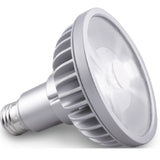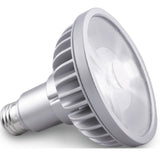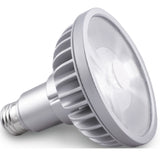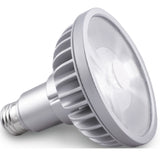Step by Step, How to Buy an LED Bulb for Your Home
Posted by Dave on for ProLampSales
We'll give it another try in this article.
With incandescent bulbs, when they burn out, you look at the watts printed on the bulb. That's basically all you need to know to buy a new incandescent bulb that performs just like the old one.
When you set out to buy an LED bulb, knowing the watts of your incandescent or halogen lamp is a non-starter. LED bulbs require a different set of questions.
Below are three types of common light bulbs found in homes. Listed for each one are the pieces of information you need, and other issues to think about, before you buy an LED bulb.
Table lamps, floor lamps, pendants: A-Shape bulb
(1) Brightness. You need to know how to make sure the brightness of your new LED A-shape bulb is at least equal to what you are accustomed to with your existing bulbs.
The wattage of your old bulb won't help you. LED bulbs have watts but the only way to make sure you are getting the same brightness is to match the "lumens," or light output, of the old bulb with the new LED. You will not find lumens printed on the old bulb - maybe on the box if you still have it. Otherwise, use the table below to convert the incandescent watts (that are printed on the bulb) to approximate lumens. Once you know the lumens, look for LED bulbs that come close to matching the lumens for your current wattage bulbs.
- 20W incandescent = 200 lumens
- 40W = 450 lumens
- 60 watts = 800 lumens
- 75 watts = 900 lumens
- 100 watts = 1200 lumens
- 120 watts = 1500 lumens
(2) Appearance of the Light. You probably like the soft, warm white light from incandescent for your table lamps and decorative lighting and you want the same warm white light from LED. Or maybe you like the idea of cooler light. With LED you get your choice. Sometimes you'll see the appearance of light written as a numerical value called color temperature. Color temperature can also be described in plain English. Use the table below to select how you want the light to appear in your table lamps and decorative fixtures.
- Warm White = 2700K (this corresponds to the typical incandescent light bulb)
- Neutral White = 3000K (slightly less warm, more typical of a halogen bulb)
- Cool White = 3500K - 4100K (similar to fluorescent lighting in offices)
- Very Cool White = 5000K - 6000K (approaching the color of daylight)
(2.5) Lighting Facts Label. Both color temperature and lumens are printed on the "Lighting Facts" label on most consumer bulbs, especially LED bulbs. If you're in doubt whether a bulb is warm or cool light, 400 or 800 lumens, check the lighting facts label.
(3) Dimming. Not all LED bulbs are dimmable. Before you buy one, make sure you know if dimming is important or not.
If you want dimming, you also need to know if the dimmable LED you purchase will dim (just like your old incandescent) on your existing dimmer. Older style residential dimmers (with no neutral) may not provide smooth dimming and worse, possibly cause your new LED to flicker. A newer style existing incandescent dimmer may work to your satisfaction. But you will get the best dimming performance using a recommended dimmer built to work with LED bulbs.
If the manufacturer is on top of it, they will provide you with a list of dimmers that will do the best job. Many of our LED bulbs have a dimmer compatibility list, either on the page or in a downloadable PDF. See this dimmable 2700K A19 LED for an example.
(4) Dimmable vs Warm Dimming. Unless the information about the dimmable LED bulb says it is "warm dimming," then assume that when the bulb is dimmed on ANY dimmer, the illumination will not get warmer in color. With incandescent, the light appears warmer and warmer as it is progressively dimmed. If you want the LED to mimic the incandescent, get one that specifically states it has warm dimming.
Recessed can lights: R or BR bulbs
(1) Brightness, Appearance of Light and Dimming answer the questions as above.
(2) Diameter of Bulb. You need to make sure the diameter of the LED bulb will fit into your can lights. If your existing reflectors have R20, BR30 or BR40 printed on the bulb, find LED reflector bulbs with the same designations. Here are the actual diameters for reference:
- R20 = 2.5"
- BR30 = 3.75"
- BR40 = 5.0"
(3) Heat and Air Flow. LED bulbs generate heat, not on the face of the bulb like incandescent, but in the body of the bulb down toward the base. The fins commonly seen on LEDs are heat sinks to help dissipate heat generated in the solid state components. These heat sinks need air flow around them to function optimally.
When LED bulbs are placed in recessed cans, the air flow around the heat sink will be reduced. LED bulbs don't have a filament to burn out, but they do have solid state components that can fail because they get too hot. Those components are located near the base of the bulb. In recessed can lights, that is the part of the bulb that gets the hottest.
It's difficult to be precise about how LED bulb life will be affected in fixtures with restricted air-flow. Eventually this information will be more available. For now our best advice is that the LED reflector bulb will probably last much longer than your incandescent, but may not last the rated life listed by the manufacturer.
Flood lights, spots and accents: PAR bulbs
(1) Brightness. For PAR flood lights, if you match your existing halogen bulb lumens with LED lumens, you will get very similar brightness.
But for spot lights it's more complicated. Something called "center beam candlepower" or CBCP is the more accurate value to match. The CBCP may be on the box of your halogen PAR, but if not you'll have to do a lookup on the web to track down the value for your brand and model of bulb.
(2) Light Appearance and Dimming same answers to questions as above.
(3) Light Distribution. With directional lighting you also want to match the light distribution beam angle, for example, 25°, 40°, etc. If the beam angle is not printed on your existing halogen PAR bulb (or on the box if you still have it), you may find the words "Spot," "Narrow Flood," or "Flood." Here is a table with a few representative beam angle values:
- 12° to 20° = Spot
- 25° to 30° = Narrow Flood
- 35° to 40° = Flood
- >45° = Wide Flood
Look for the Energy Star Logo for Extra Energy Savings
After you've identified the LED bulbs that meet your requirements based on the issues discussed above, see which ones are Energy Star qualified.
These bulbs will have met energy efficiency standards that can add assurance to your purchase.
Special Cases & Rules of Thumb
There will always be exceptions to the rules of thumb discussed here. But if you address each of the issues raised for the different types of bulbs found in most homes, you should end up with an LED that meets your expectations.
Commercial and industrial applications may have other issues to address in addition to those stated here.
Featured Products (View All)
0 Comments




